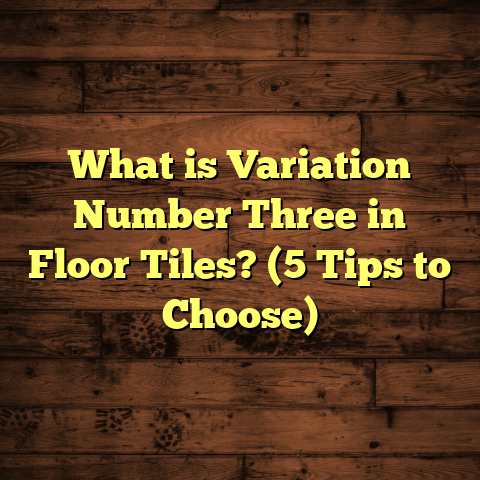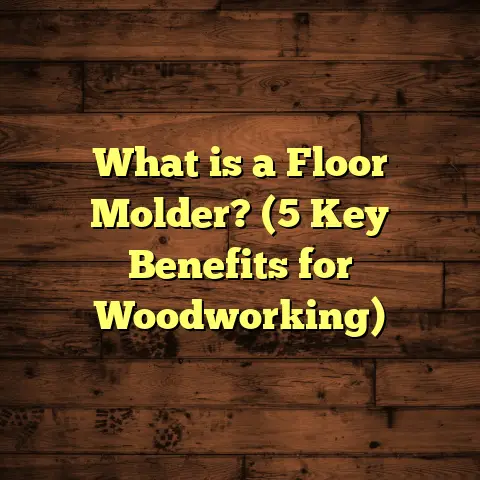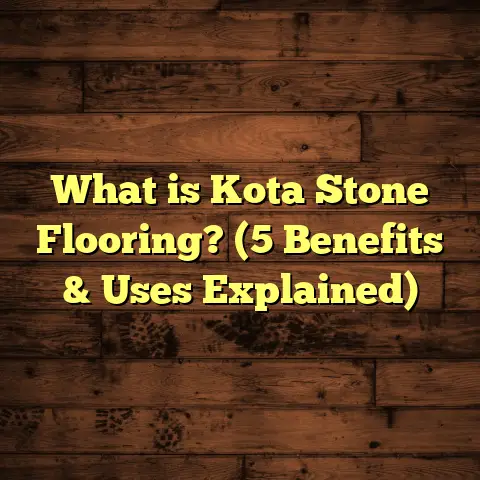What is Water Popping on Floors? (5 Tips for Prevention)
Durability is a big deal when it comes to flooring. Over the years, I’ve installed and repaired countless floors—some that have lasted for decades despite heavy foot traffic, pets, kids, and all the daily wear and tear that comes with a busy home. But even the toughest floors can face challenges. One of the sneakiest issues I’ve encountered on numerous projects is water popping. If you’re scratching your head wondering, “What exactly is water popping on floors?” you’re not alone. I want to take you through everything I’ve learned about this problem, from what it is to how to prevent it, sharing stories, data, and advice along the way.
What Is Water Popping on Floors?
Let’s start at the beginning: what is water popping? The term might sound like something fun or harmless, but in the flooring world, it’s actually an issue you want to avoid.
Water popping happens when moisture gets trapped underneath the surface of your flooring and causes bubbles or blisters to form. These raised spots or bumps can feel weird underfoot and eventually damage the floor’s surface.
I’ve seen it most often with laminate floors, engineered hardwood, vinyl planks, and even some hardwood floors, especially in places like kitchens, bathrooms, basements, or anywhere moisture tends to hang around.
Think of it like this: moisture sneaks under your flooring—maybe from a slow leak, a spill left too long, or even humidity—and starts to push up against the floorboards. The floor material swells where that moisture is trapped and creates “popped” areas that look like little bubbles or blisters.
Why does this happen? It’s all about moisture meeting materials that don’t handle water well. Wood and laminate are especially vulnerable because they absorb moisture and expand. Vinyl and engineered floors can blister if moisture gets under the top layer.
Breaking Down the Causes of Water Popping
Understanding why water popping happens helps you avoid it. Let me walk you through what I’ve seen as the main causes:
1. Moisture Seepage From Leaks or Spills
In many cases, water popping starts with a leak or spill that goes unnoticed for a while. Even small amounts of water can cause trouble if they get under the floor.
For example, I worked on a house where the homeowner had just installed laminate flooring in the kitchen. Everything looked perfect until about a month later when little bubbles started forming near the sink. After investigating, I discovered a dishwasher leak had slowly allowed water to seep underneath.
Small leaks behind appliances, under sinks, or from pipes are common culprits. Even spills that aren’t wiped up promptly can work their way into seams or cracks.
2. High Indoor Humidity and Condensation
You might not realize it, but humidity plays a huge role in water popping. In areas with high humidity—like basements or bathrooms—moisture can settle beneath floors without any actual liquid spill.
In coastal areas, for instance, I’ve seen floors bubble and swell due to constant moisture in the air. When warm air meets a cold subfloor or concrete slab below, condensation forms and gets trapped under flooring materials.
3. Poor Installation Practices
Installation errors can open the door for water issues:
- No vapor barrier: This is a must when installing floors on concrete slabs or below grade. Without a vapor barrier, moisture from the ground can seep upwards.
- Improper acclimation: Flooring materials like hardwood and laminate need time to adjust to room temperature and humidity before installation. If you skip this step, expansion and contraction after installation can trap moisture.
- Tight seams and incorrect adhesives: Flooring that doesn’t allow for proper expansion or uses wrong adhesives can trap moisture in pockets.
4. Damp Subfloors
Sometimes the problem starts even before the floor goes down. If the subfloor isn’t fully dry when flooring is installed, trapped moisture can cause popping later.
I recall a case where plywood subflooring was installed over a concrete slab that hadn’t had enough time to cure properly after pouring. The residual moisture caused bubbling within weeks.
5. Material Sensitivity
Not all flooring materials react the same to moisture. Laminate and engineered wood are particularly sensitive because they have layers glued together—if water gets in between those layers, popping can occur.
Vinyl planks are generally more water-resistant but can still blister if moisture becomes trapped underneath.
How Serious Is Water Popping?
You might be thinking, “Okay, but how bad can this really get?” From my experience and data-backed research, water popping isn’t just an aesthetic problem—it’s often a warning sign of deeper issues.
According to a 2022 report by the National Wood Flooring Association (NWFA), moisture-related failures account for about 35% of all flooring problems in residential homes. That’s over a third of issues directly tied to moisture!
Ignoring water popping can lead to:
- Warped or buckled boards which become safety hazards.
- Mold and mildew growth beneath the floor causing health risks.
- Structural damage to subfloors if moisture persists.
- Unpleasant odors that can linger.
- Reduced property value, as damaged flooring is costly to replace.
I remember one client who delayed repairs for water popping caused by an unnoticed leak under their kitchen floor. Within months, boards warped badly and mold developed in the subfloor, leading to $15,000+ in repairs—not just flooring replacement but structural fixes too.
Early Signs of Water Popping: What You Should Watch For
Catching water popping early can save you headaches and money. Here’s what I tell homeowners to look out for:
- Raised bumps or bubbles on the floor surface.
- Soft or spongy spots when walking barefoot.
- Unusual creaking or popping sounds as you move around.
- Discoloration or dark spots on floorboards.
- A musty smell indicating mold growth beneath.
- In extreme cases, visible mold spots on edges or underneath removable flooring sections.
If you suspect moisture but don’t see visible signs yet, using a moisture meter can help detect hidden dampness beneath floors. These devices measure humidity levels inside wood or subfloors and are invaluable for early detection.
On one job, a simple moisture meter reading alerted me to a hidden plumbing leak under laminate flooring before bubbles appeared. Catching it early prevented costly damage.
My Top 5 Tips for Preventing Water Popping on Floors
After years of installations and repairs, I’ve learned some practical ways to keep floors safe from water popping. Here are my best tips:
1. Properly Acclimate Your Flooring Materials
Before installing hardwood or laminate floors, always let the materials sit in the room for several days at least. Why? Because wood adjusts to humidity and temperature changes naturally.
If you install wood right out of a dry warehouse into a humid room, it will expand later—leading to gaps or popping if moisture gets trapped.
I’ve seen projects saved simply by waiting 72 hours for acclimation before starting installation.
2. Use Quality Vapor Barriers
Vapor barriers prevent moisture from rising up from concrete slabs or ground beneath your home. Polyethylene sheets or specialized membranes reduce moisture transmission by as much as 90%, according to product testing data.
I never skip this step when working on homes with concrete subfloors or below-grade rooms like basements. Even if you think your area is dry, vapor barriers provide peace of mind.
3. Control Indoor Humidity Levels
Maintaining indoor humidity between 35% and 55% is ideal for flooring health. Too much humidity causes swelling; too little causes shrinkage and cracking.
Using dehumidifiers in basements or humid climates helps maintain balance.
One winter I worked through in a coastal home showed me how controlling humidity prevented popping even when outside conditions were extreme (humidity above 80%).
4. Wipe Up Spills Immediately & Fix Leaks Fast
This might sound obvious but many water-popping problems come down to neglecting spills or slow leaks.
If you spill water on your floor—clean it up right away! Don’t let it sit for hours or days.
Regularly check plumbing fixtures behind sinks, under appliances like dishwashers and washing machines for leaks before they cause damage.
5. Choose Flooring Materials According to Your Needs
Some materials are simply better at handling moisture:
- Luxury Vinyl Planks (LVP) are nearly waterproof.
- Engineered hardwood with advanced finishes offers better resistance than solid wood.
- Avoid traditional laminate in areas prone to spills unless it’s specifically rated as waterproof.
Selecting the right material reduces your risk dramatically from day one.
Case Study: Water Popping in a Coastal Home
Here’s a real-life example that stuck with me:
I was called out to a beach house where laminate floors had started bubbling within just two months after installation. The owners were frustrated—they thought they did everything right but hadn’t installed a vapor barrier because they assumed coastal air wouldn’t affect floors indoors.
The house faced constant salt air and high humidity (often over 75%). What happened? Condensation formed between the cool concrete slab foundation and laminate planks without any vapor barrier to block moisture movement.
We had to pull up sections of flooring to dry out the subfloor completely, install a high-quality vapor barrier plus a moisture-resistant underlayment, then replace damaged planks with waterproof vinyl in trouble areas like bathrooms and kitchens.
Since then? No new bubbling—even during hurricane season when humidity soared past 80%.
This case taught me never to underestimate environmental factors—even seemingly dry indoor spaces can trap moisture under floors if precautions aren’t taken.
What Happens if You Ignore Water Popping?
You might think some popping is just cosmetic or minor—but ignoring it often leads to bigger problems:
- Swollen boards lose their shape and can buckle up creating tripping hazards.
- Persistent moisture invites mold growth beneath floors which affects indoor air quality.
- If subfloors get damaged by water over time, you risk structural problems.
- Moldy floors smell bad—imagine trying to sell your home with that odor lingering!
- Repair costs skyrocket when damage spreads beyond surface boards.
I once consulted with a family who waited six months before calling me about popping vinyl planks under their kitchen table. The damage had spread so much that we had to remove all flooring on that level—a job that cost over $12,000!
How Professionals Fix Water Popping
Professional repair depends on how bad the damage is:
- Remove bubbled or warped flooring sections carefully.
- Dry out subfloor thoroughly with industrial fans/dehumidifiers.
- Fix any plumbing leaks or sources of moisture.
- Install vapor barriers or improve ventilation if needed.
- Reinstall new flooring materials properly acclimated and sealed against moisture.
For hardwoods with minor surface issues, sanding and refinishing might fix appearances but underlying moisture must be addressed first.
Unique Insights from My Experience
One thing I’ve noticed over years on jobsites is that many moisture problems come from overlooked sources:
- Cold water pipes running beneath floors cause condensation dripping onto subfloors.
- Crawl spaces without ventilation trap moist air which seeps upwards.
- Roof leaks dripping into walls eventually find their way down to floorboards unnoticed.
I’ve solved several cases simply by adding crawl space vents or insulating pipes properly before redoing floors.
Also, some newer flooring products come with built-in moisture resistance layers which reduce popping risk significantly—a great investment if your home has known humidity problems.
The Science Behind Moisture & Flooring Interaction
Understanding how moisture affects flooring at a microscopic level helps explain why some materials pop while others don’t:
Wood is hygroscopic—meaning it absorbs and releases moisture depending on surrounding conditions. When wood fibers soak up water vapor or liquid water:
- The fibers swell unevenly causing boards to warp or buckle
- Adhesives in laminates soften leading to delamination (layers separating)
Vinyl materials are less absorbent but can trap steam underneath if sealed improperly causing blistering as pressure builds up internally.
Concrete slabs release water vapor slowly over time—especially new pours can take months to dry fully (sometimes years). Without barriers, this vapor migrates into flooring layers causing damage long after installation.
Preventive Maintenance Tips Beyond Installation
Once your floor is installed correctly, ongoing care matters:
- Maintain consistent indoor temperature/humidity year-round.
- Use area rugs in high-moisture zones (e.g., entryways) to catch spills.
- Regularly inspect plumbing appliances for slow leaks.
- Clean spills immediately using absorbent cloths—not wet mops.
By following these routines, you’ll protect your investment and reduce risk of future popping issues.
How Much Does Water Popping Repair Cost?
Repair costs vary depending on severity:
| Damage Level | Typical Cost Range | Notes |
|---|---|---|
| Minor bubbling | $200 – $800 | Spot repairs; sanding/refinishing |
| Moderate damage | $800 – $3,000 | Partial floor replacement |
| Severe/widespread | $3,000 – $10,000+ | Full floor removal & replacement |
Keep in mind ignoring early signs often leads to higher costs later on due to mold remediation and structural repairs as well.
Tools & Products I Recommend for Moisture Prevention
Here are some items I trust:
- Moisture meters: Wagner MMC220 or General Tools MMD7NP
- Vapor barriers: 6-mil polyethylene sheets (Black/clear options)
- Underlayments: Moisture-resistant foam or cork pads
- Dehumidifiers: Frigidaire FFAD7033R1 for residential use
- Sealants: Bona Traffic HD (hardwood finish) for added protection
Using these during installation and maintenance helps keep floors safe from moisture damage.
FAQs About Water Popping on Floors
Q: Can water popping happen on solid hardwood?
A: Yes, especially if there’s excess moisture under the floorboards or poor acclimation during installation—but solid hardwood is generally more stable than laminate when properly installed.
Q: Is water popping covered by warranty?
A: It depends on manufacturer terms but most warranties exclude damage from improper installation or neglect of spills/leaks.
Q: Can I fix small bubbles myself?
A: Sometimes minor bubbling can be popped back down temporarily but this won’t solve underlying moisture problems—professional assessment is best.
Wrapping Up With Some Real Talk
Water popping might sound like something trivial until you actually face it—and believe me, it’s anything but trivial once your floor starts bubbling. It affects more homes than people realize and leads to expensive repairs if ignored.
I hope sharing my experiences and tips gives you confidence to spot risks early and protect your floors effectively. If you ever run into signs of water popping—or just want advice tailored to your home—reach out anytime. Flooring isn’t just about looks; it’s about building something durable and beautiful that lasts for years without surprises beneath your feet.
Take care of your floors like you would any important part of your home—and they’ll reward you with years of durability and comfort!
If you want help estimating costs for your next project—including factoring in materials that resist moisture—I use FloorTally, an excellent tool for budgeting based on local labor/material costs with waste factors included. It’s saved me tons of time getting accurate bids and making smart choices—and it could help you too!
Happy flooring!





